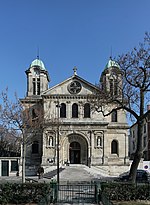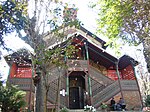La Villette, Seine

La Villette (French pronunciation: [la vilɛt] ) was a French commune (municipality) in the Seine département lying immediately north-east of Paris. It was one of four communes entirely annexed by the city of Paris in 1859. Its territory is now located in the 19th arrondissement, but a neighborhood has retained its name: the quartier de La Villette and the Parc de la Villette. A Gallo-Roman village stood here along the Roman road that led north from Lutetia. About 1198 the district was named the Villa Nova Sancti Lazari, in French Ville Neuf Saint-Ladre, the "new village of Saint-Ladre", which referred to the leper hospice dedicated to the lepers' patron Saint Lazare (Ladre); it became Villette-Saint-Ladre-lez-Paris in a document of 1426. In 1790, the Constituent Assembly of Revolutionary France raised the hamlet to the status of a commune.
Excerpt from the Wikipedia article La Villette, Seine (License: CC BY-SA 3.0, Authors, Images).La Villette, Seine
Rue de Joinville, Paris Quartier de la Villette (Paris)
Geographical coordinates (GPS) Address Nearby Places Show on map
Geographical coordinates (GPS)
| Latitude | Longitude |
|---|---|
| N 48.89 ° | E 2.38 ° |
Address
Rue de Joinville 14
75019 Paris, Quartier de la Villette (Paris)
Ile-de-France, France
Open on Google Maps











